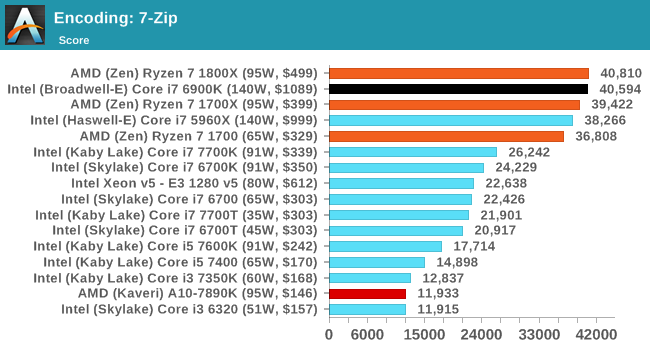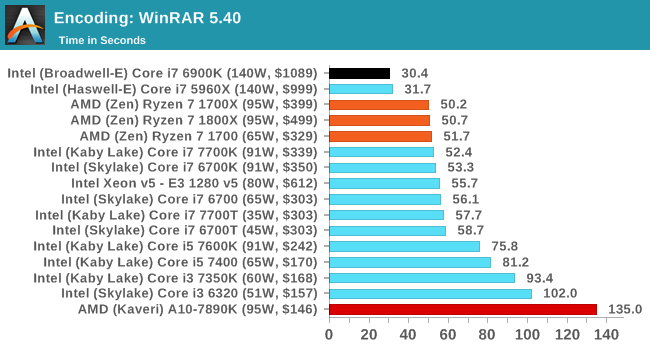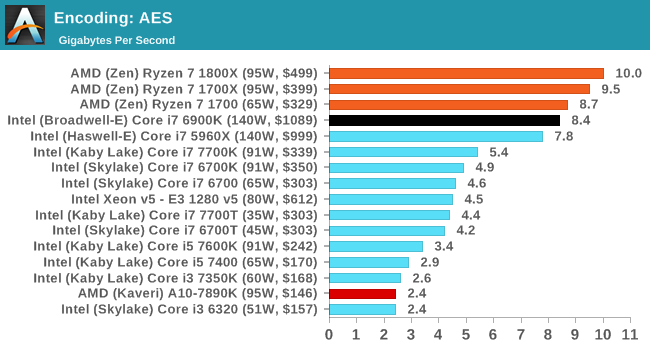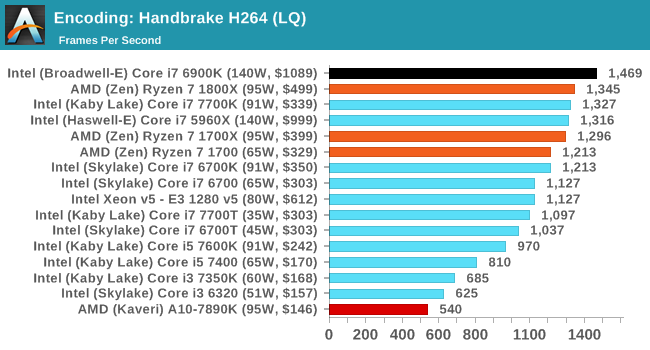The AMD Zen and Ryzen 7 Review: A Deep Dive on 1800X, 1700X and 1700
by Ian Cutress on March 2, 2017 9:00 AM ESTBenchmarking Performance: CPU Encoding Tests
One of the interesting elements on modern processors is encoding performance. This includes encryption/decryption, as well as video transcoding from one video format to another. In the encrypt/decrypt scenario, this remains pertinent to on-the-fly encryption of sensitive data - a process by which more modern devices are leaning to for software security. Video transcoding as a tool to adjust the quality, file size and resolution of a video file has boomed in recent years, such as providing the optimum video for devices before consumption, or for game streamers who are wanting to upload the output from their video camera in real-time. As we move into live 3D video, this task will only get more strenuous, and it turns out that the performance of certain algorithms is a function of the input/output of the content.
7-Zip
One of the freeware compression tools that offers good scaling performance between processors is 7-Zip. It runs under an open-source licence, is fast, and easy to use tool for power users. We run the benchmark mode via the command line for four loops and take the output score.

WinRAR 5.40
For the 2017 test suite, we move to the latest version of WinRAR in our compression test. WinRAR in some quarters is more user friendly that 7-Zip, hence its inclusion. Rather than use a benchmark mode as we did with 7-Zip, here we take a set of files representative of a generic stack (33 video files in 1.37 GB, 2834 smaller website files in 370 folders in 150 MB) of compressible and incompressible formats. The results shown are the time taken to encode the file. Due to DRAM caching, we run the test 10 times and take the average of the last five runs when the benchmark is in a steady state.

AES Encoding
Algorithms using AES coding have spread far and wide as a ubiquitous tool for encryption. Again, this is another CPU limited test, and modern CPUs have special AES pathways to accelerate their performance. We often see scaling in both frequency and cores with this benchmark. We use the latest version of TrueCrypt and run its benchmark mode over 1GB of in-DRAM data. Results shown are the GB/s average of encryption and decryption.

HandBrake H264 and HEVC
As mentioned above, video transcoding (both encode and decode) is a hot topic in performance metrics as more and more content is being created. First consideration is the standard in which the video is encoded, which can be lossless or lossy, trade performance for file-size, trade quality for file-size, or all of the above can increase encoding rates to help accelerate decoding rates. Alongside Google's favorite codec, VP9, there are two others that are taking hold: H264, the older codec, is practically everywhere and is designed to be optimized for 1080p video, and HEVC (or H265) that is aimed to provide the same quality as H264 but at a lower file-size (or better quality for the same size). HEVC is important as 4K is streamed over the air, meaning less bits need to be transferred for the same quality content.
Handbrake is a favored tool for transcoding, and so our test regime takes care of three areas.
Low Quality/Resolution H264: He we transcode a 640x266 H264 rip of a 2 hour film, and change the encoding from Main profile to High profile, using the very-fast preset.

High Quality/Resolution H264: A similar test, but this time we take a ten-minute double 4K (3840x4320) file running at 60 Hz and transcode from Main to High, using the very-fast preset.

HEVC Test: Using the same video in HQ, we change the resolution and codec of the original video from 4K60 in H264 into 1080p30 HEVC. This causes a dramatic reduction in filesize.











574 Comments
View All Comments
bobsta22 - Saturday, March 4, 2017 - link
Office with 20 PCs - all developers - loads of VMs and containers.All the PCs are due a CPU/Gfx refresh, but ITX mobos required.
Cant wait tbh. This is a game changer.
prisonerX - Saturday, March 4, 2017 - link
What if they come out with a 16 core line next year!bobsta22 - Saturday, March 4, 2017 - link
What?lilmoe - Tuesday, March 7, 2017 - link
It really is. As a freelance developer, I can't wait.ericgl21 - Saturday, March 4, 2017 - link
For me, the more important thing to see from AMD is if they can come up with a chip that can beat the mobile Core i7-7820HQ (4c/8t no ECC) & the Xeon E3-1575M v5 (4c/8t with ECC), for less money.And the number of PCIe gen3 lanes is very important, especially with the rise of M.2 NVMe storage sticks.
cmagic - Sunday, March 5, 2017 - link
Will anandtech review Ryzen in gaming? I would really like Anandtech view, since I don't really trust other sites especially those "entertainment" sites. Want to see how Anandtech dive into its main cause.Tchamber - Sunday, March 5, 2017 - link
@cmagicPage 15
2017 GPU
The bad news for our Ryzen review is that our new 2017 GPU testing stack not yet complete. We recieved our Ryzen CPU samples on February 21st, and tested in the hotel at the event for 6hr before flying back to Europe.
I just ordered my 1700X, I plan to keep it for at least 5 years, as my needs don't change much. My current Intel 6 core is coming up on 7 years old now. I like to buy high end and use it a long time.
Lazlo Panaflex - Monday, March 6, 2017 - link
Same here...probably gonna grab a 1700 at some point and put this here i5-2500 non-k in the kids computer.asH98 - Sunday, March 5, 2017 - link
'''The BIG QUESTION is WHY are the HEDT benchmarks (professional ie Blender) fairer than gaming benchmarks??Bottom line is that CUTTING-EDGE CODING is happening NOW in AI, HPC, data, and AV/AR, game coders because of $$$ are the last to change or learn unless forced (great for NVidia Intel) so most of the game coding is stuck in yesteryear- Bethesda will be the test bed for game coders to move forward
Hence the difference in game benchmarks vs 'professional' (HEDT) benchmarks. Game coders can get stuck using yesterday's code without repercussions and consequences as long as old hardware dominates and there are no incentives to change or learn new skills. The same Cant happen in the Professional area where speed is tantamount to performance and $$$
TheJian - Sunday, March 5, 2017 - link
I hope you're going to test a dozen games at 1080p where most of us run for article #2 and the GAMING article should come in a week not 1/2 year later like 1080/1070 gtx reviews...LOL. As this article just seems like AMD told you "guys, please don't run any games so we can sell some chips to suckers before they figure out games suck". And you listened. No point in testing 1440p or 4k for CPU, and 95% of us run 1920x1200 and BELOW so you should be testing your games there for a CPU test.The fact they are talking Zen2 instead of fixing Zen1 kind of makes me think most of the gaming is NOT going to be fixable.
http://www.legitreviews.com/amd-ryzen-7-1800x-1700...
149fps for 7700 in theif vs. 108 for 1800x? JEEZ. GTA5 again, 163 to 138. Deus ex MD 127 to 103. These are massive losses to Intel's chip and Deus was clearly gpu bound as many of Intel's chips hit the same 127fps including my old 4790k :( OUCH AMD.
https://www.guru3d.com/articles_pages/amd_ryzen_7_...
Tombraider same 7700k vs. 1800x 132fps to 114 (never mind 6850 scoring 140fps). This will probably get worse as we move to 1080ti, vega, nvidia refresh for xmas, Volta, 10nm etc. If you were using a faster gpu the cpus will separate even more especially if people are mostly gaming at 1080p. Even if many move to 1440p, that maybe fixes some games (tombraider is one with 1080 regular that hits a wall at 90fps), but again goes back to major losses as we move to 10nm etc. We get 10nm chips for mobile now and gpus probably next year at 12nm (real? fake 12nm? Either way) and might squeak into 2017 (volta, TSMC). 10nm gpus will likely come 2018 at the latest. Those gpus will make 1440p look like 1080p today surely and cpus will again spread out (and no, we won't all be running 4k then...LOL). You could see cpus smaller than 10nm BEFORE you upgrade your cpu again if you buy this year. That could get pretty ugly if the benchmarks around the web for gaming are not going to improve. One more point you'll likely be looking at GDDR6 (16Gbps probably) for vid cards allowing them to possibly stretch their legs even more if needed. Again, all not good for a gamer here IMHO.
“But Senior Engineer Mike Clark says he knows where the easy gains are for Zen 2, and they're already working through the list”
So maybe no fix in sight for Zen1? Just excuses like "run higher res, and code right guys"...I hope that isn't the best they've got. I could go on about games, but most should get the point. I was going to buy ryzen purely for Handbrake, but I'll need to see motherboard improvements and at least some movement on gaming VERY soon.
One more ouch statement from pcper.
https://www.pcper.com/news/Processors/AMD-responds...
"For buyers today that are gaming at 1080p, the situation is likely to remain as we have presented it going forward."
So they don't think a fix is coming based on AMD info and as noted as gpus get much faster (along with their memory speeds) expect 1440p to look like today's 1080p benchmarks at least to some extent.
The board part is of major interest to me, so I can wait a bit and also see Intel's response. So AMD has be hanging for a bit here, but not for too long. I do like the pro side of these though (handbrake especially, just not quite enough).